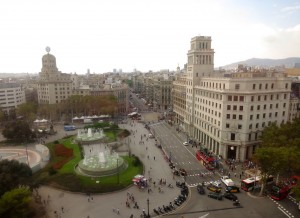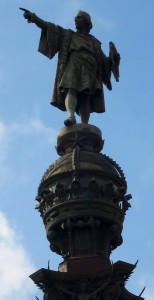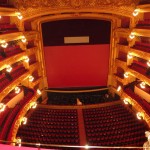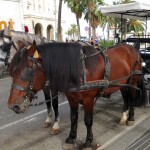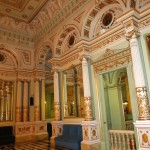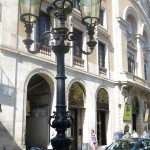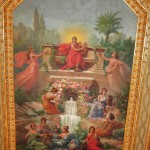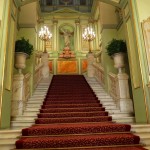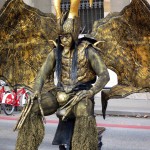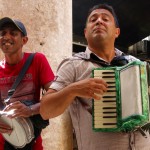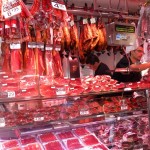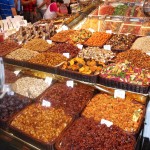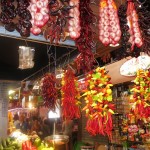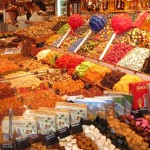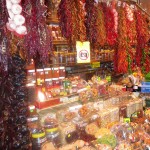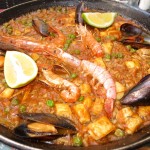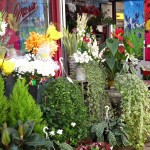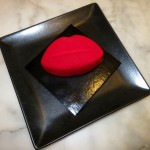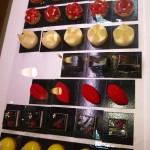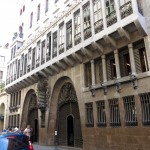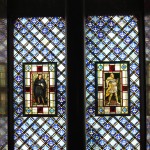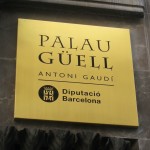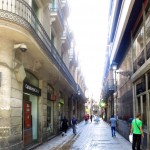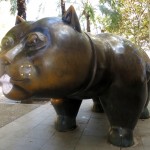La Rambla is the promenade street in central Barcelona with two narrow one-way traffic roads which run on either side of the central Ramblas pedestrian boulevard. Always popular with tourists as well with Catalonians parading, sometimes protesting their independence, but always enjoying themselves. This is a tree-lined pedestrian mall that runs for 1.2 kilometres between Plaça de Catalunya at the city end and the Christopher Columbus Monument and Port Vell at the opposite end.
Starting at the top of the Ramblas, around Plaça de Catalunya and facing towards the port, you will see wonderful fountains where legend has it, if you drink the water in the fountain, you will return to Barcelona. It certainly seems true for us, considering this is our third visit to this bustling, tourist mecca. In the nearby central square there are many city tour buses and you will also find El Corte Inglés Department Store, where on the ninth floor, you can have a fantastic lunch (reasonably priced) while enjoying a superb view over the whole of Barcelona. You can also eye off some Spanish fashion on your way up to the restaurant and be sure to grab a bargain at a rebajas (sale) on your way out.
- Have an artist sketch your portrait.
- Eat at one of the many sidewalk cafés and bars.
- Looking down at the stage from the gallery.
- You might decide to take a ride on a horse and cart, popular all over Spain.
- Mirrors, gilded panels and hand painted friezes adorn the walls of the reception room.
- The buildings around the Ramblas indicate past style and elegance in this beautiful city
- The beautiful old Port Authority building is at the very end of the Ramblas
- The ceiling shows Apollo and the nine muses.
- The magnificent staircase in Gran Teatre del Liceu.
Also around this area there are many interesting street cafés, bars and restaurants. Towards the middle of the Ramblas on the right (heading towards the port end) we found Escriba Patisserie trading since 1902. Here we had the most exquisite cakes in all of Barcelona. The superb, brilliant raspberry coloured, lip–shaped cakes filled with vanilla cream and raspberry coulis begged for a taste test. Call in, have a coffee and a delicious treat, you will not be disappointed. If you feel guilty, you can always justify it as investigating the history of Catalonian cuisine.
Walking down the Ramblas you pass the flower sellers and outdoor restaurants where people can be seen drinking steins of beer or huge glasses of Sangria. There are the obligatory souvenir shops and you can have your portrait or caricature done by one of the many artists found here. Be careful not to bump into one of the human statues towards the sides of the Ramblas, they’re so life like. This area is totally ‘touristic’, always very busy and crowded, but the buildings, architecture and atmosphere are fantastic. Here you have found the beating heart of this vibrant city.
- Buskers will pose with passers-by for photos
- Let the local musicians and buskers
- The famous Iberico ham and meat products of every type are a feature.
- Nuts and more nuts.
- Herbs and spices from every corner of the world.
- Dried fruits and sweets of every description.
- The colours in the market are fantastic.
- Have a traditional Spanish paella with a glass of wine for a typical lunchtime treat.
- Florist shops and souvenir shops are scattered along the famous walking street.
At 69 Ramblas you will stumble across the Erotic Museum (Museu de L’Eròtica) and don’t miss Marilyn posing and waving in the top window with her white halter neck dress billowing up (accidentally of course!). Here is where you will find out about the sexy world of the Hindu Kama Sutra, erotic art banned in Japan, the origins of Spanish pornographic cinema, the history of erotic art through the eyes of the great masters of painting and the most astonishing sexual records ever kept. This place is a voyage through the world of eroticism and its representation in art, as seen in the 800 plus pieces which make up the collection. Also don’t miss rubbing the big penis, just for good luck. Enjoy the sensuality, sexuality and provocation, it’s a lot of fun (http://www.erotica-museum.com).
Opposite, on the other side of the Ramblas, you have a huge crowded market area called La Boqueria. This market is a profusion of fresh colourful fruits, arrays of Iberico hams hanging from small shop vendors, spices in tiny bottles from all over the world, freshly baked pastries, a huge variety of vegetables, fresh meats, poultry and seafood. The market also has a number of cafés and restaurants at the sides. So if you want to sit down, these are a good find. We had seafood Paella at Sukaldari Boqueria towards the front of the market, a bit pricey for what we ate but, in the heart of the market, the people watching was worth it and the gypsy buskers entertained us with their highly accomplished, accordion street music.
On the same side of the Ramblas you will find the Gran Teatre del Liceu. It is one of the most important opera houses in Europe and one of the most beautiful attractions of Barcelona. Built in 1847 it has had many reconstructions over the years as it has suffered from a number ofdestructive fires in its long history. However, this magnificent building still retains many original features including the magnificent central marble staircase, once used only by the rich and famous of the city.
Originally built for wealthy Barcelonians, it is now open to the public and the opera ticket prices are quite affordable. In the afternoon we took the 30 minute opera house tour where we saw the foyer, the main theatre (during preparations for The Barber of Seville that evening) and the large reception room that has beautiful gilded panels and a wonderful fresco of Apollo and the nine muses on the ceiling.
- We had the vanilla and raspberry lips. Totally decadent, just how they look!
- Do not miss the opportunity to have a treat at Escribà.
- Too many taste treats to choose from.
- The facade of Palau Güell resembles a Venetian villa.
- Wrought iron, stone, tile, timber and stunning stained glass feature throughout the mansion.
- Gaudis first major building work which would set new standards in his era and for the future.
Further down, just a few steps off the Ramblas in a side street (Nou de La Ramblas) is Palau Güell. This is one of the early works of Antoni Gaudí and one of the most magnificent buildings of the art nouveau period. The facade of the building resembles a Venetian palace. For an entry fee of 12€ you can see how Gaudi, commissioned by the Industrial tycoon Eusebi Güell, designed and decorated the house with impressive wrought-iron works, wood, ceramic, stained glass and stone. The tour starts by featuring the carriage hall and the spiral ramps to the stables below ground level. The other levels of the house are grand, including the staircases, bedrooms, piano room and the main entertainment room, which doubled as a chapel. On the terrace are examples of ‘typical’ Gaudi design, with a large conical spire covering the dome of the main parlour and twenty chimneys decorated with coloured tiles scattered around the undulating roof line. Many visitors to the city complete their Gaudi experience by visiting his own house and of course Park Güell.
One evening we ventured further down past Palau Güell into the area called the Raval. This area is very bohemian, where many students study music, film and art. You will also find the Museum of Contemporary Art not too far away. In the area known as Ramblas del Raval you will find many Asian restaurants. A restaurant called Suculent in this street was highly recommended to us but unfortunately, on several occasions when we tried to eat there, it was closed. You may have better luck!
Returning to the central Ramblas and walking to the opposite side from Palau Guell, you will discover the old town. Here you will find many bars and restaurants in magnificent large central squares, boutique shops and winding streets and buildings dating back to the 14th century, illuminated spectacularly at night and representing a very special feature of Barcelona. This is one of those Spanish labyrinths where you should just wander and follow your instincts to discover delicious food, unexpected bargains and souvenirs. (However, do take care in this area as there have been stories of tourists being threatened and even robbed in some of the lonely little alleyways.)
- Make a stop on the Ramblas at the Erotic Museum for something a little different.
- On either side of the Ramblas are winding alleyways and narrow streets to explore.
- The sculpture of the Cheshire Cat is a symbol of Ramblas del Raval.
Back on the central Ramblas, as you make your way towards Port Vell, you will see the Wax Museum and many more buskers. At the end of the Ramblas looking out to sea is the magnificent 60 metre tall statue of Christopher Columbus (Estàtua de Colom). It was constructed for the Expo Universal de Barcelona (1888) in honour of Columbus‘s first voyage to the Americas. The monument serves as a reminder that Christopher Columbus reported to Queen Isabella I and King Ferdinand V in Barcelona after his first trip to the new continent.
The Ramblas is one of the magnificent boulevards of the world and you should explore it in the day time and promenade with the locals and tourists in the evening. Each time we have returned, it offers up exciting new touristic treats which lure us into just rambling around here, delaying our exploration of other parts of this delightful city.
